
August 2019
I really appreciate being here. I’m grateful to Scott, and John Lynch, and all of the FairMormon board members, and everyone who’s allowed me to participate. I’m also really glad not to be talking about polygamy. As I was researching plural marriage, which I’ve done for decades, I would sometimes have people ask me, are you worried about what you’re going to find? And how it might affect your testimony? And in the back of my mind I always had this belief Joseph Smith could not have created the Book of Mormon. And so he was a prophet in 1829, in my thinking, and so I didn’t think he lost that mantle, that he fell, and so I never was really too worried about what I might find as we’re looking under stones, me and Don Bradley, to try to understand the plural marriage things in Nauvoo.

And then about four years ago when I stopped researching polygamy and writing on that topic, I thought, let’s test this theory that Joseph couldn’t have produced the Book of Mormon. So what you’re seeing here is a culmination of some of the research that I’ve been doing for several years.

There is an article coming out in BYU Studies in the very next issue, it will probably be out in the next couple of weeks. There’ll be an online version. Steve Harper, I’m grateful to him, but it will cover a lot of the same material that I’ll have here today. Again, I’m grateful for BYU Studies and their willingness to do this.


Now when we talk about the Book of Mormon, I think everyone here knows we’re talking about a big book, with a lot of moving parts if you will, and one thing I want to point out is that it’s written to about an eighth-grade reading level. There’s lots of algorithms that people will put books into, and it comes out at least at an eighth-grade level, or some of the algorithms say it’s even more complex than that and should be even college level.

If you’re interested in this material, I refer you to this article in Interpreter. And I love Interpreter and I’m grateful to Dan and all of his crew for their work allowing this article. But it talks about how you calculate the reading level of the Book of Mormon.
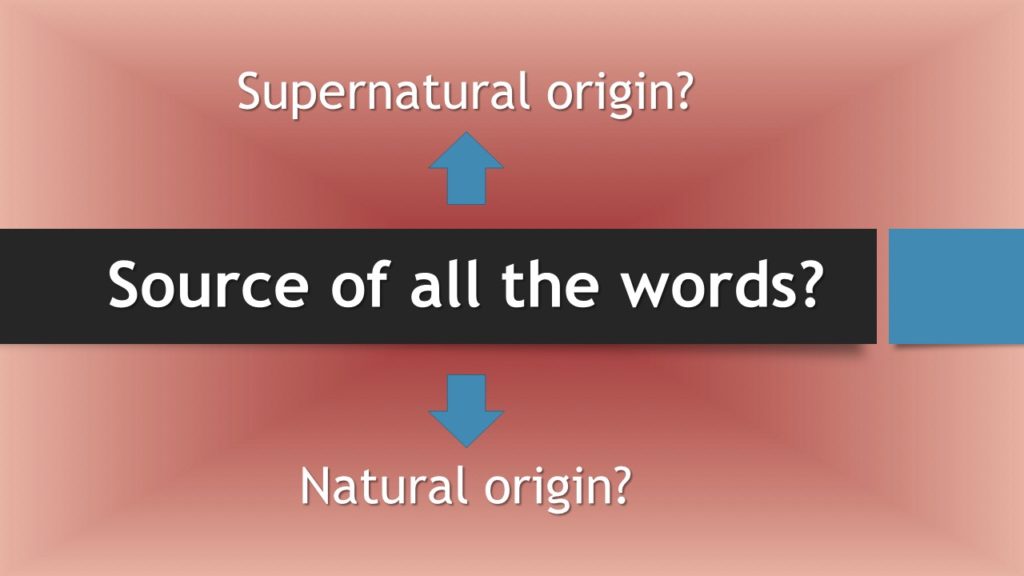
Joseph Smith said he received the words of the Book of Mormon through supernatural influences. But just as soon as he was making this claim, the people around him—critics, who are always with us and always will be, at least until the Lord comes again—they were saying, no, this is natural. The Book of Mormon came through natural means. And things were being published, even before the Book of Mormon was printed, saying these things, giving this message: it came through natural efforts.

And then if you fast forward to the last few decades, there have been dozens, if not hundreds of books, with the message that Joseph Smith was able to produce the Book of Mormon through natural means. It’s interesting to me how many of these publications come from Signature Books, but that’s just kind of a side discussion.
I think the most prominent two are Fawn Brodie’s book and my friend Dan Vogel’s book that champion this idea that the Book of Mormon came through natural means.
And so what I’ve done the last four years is created a database.

And quickly, see if you can read fast—I’m just kidding.

But I just wanted to demonstrate that it’s got about 65,000 words in it, but I’ve taken excerpts from 170-plus secular sources telling how Joseph was able to create all those words. And if we chart these, we find there’s really five predominant theories. There’s the Solomon Spalding theory, collaboration with someone, mental illness, automatic writing, and then Joseph’s intellect.

And if we look at them chronologically, notice the far-right column. That’s Joseph Smith’s intellect. Originally Joseph is dumb; the Book of Mormon is dumb. So that’s how it was produced. But look at the first column, Solomon Spalding. In 1834 it’s introduced, and then everybody is jumping on this bandwagon for the next 50 years. And then something happens, and then there’s a smattering of ideas, and people aren’t sure exactly, and again things start to shift over to the Joseph Smith’s intellect—his brain was sufficient to do it. And that’s by far and away the most predominant theory today.

If we track these graphically this way, we see the dark purple is Joseph Smith’s intellect. That’s at the beginning. And then we see predominating at the end there’s the pink there for the Solomon Spalding theory.

So what we’re going to do is talk about these five theories. These are the most predominant ones from the naturalists explaining where Joseph got all of the words.

Now the Spalding theory, begins in 1812 with Solomon Spaulding writing a manuscript. And we call it “Manuscript Story.”
It has different names sometimes depending on who you’re reading, but he shares this manuscript with his neighbors. He reads it to them. Or he lets them use it. They borrow it and read it. He dies four years later. And according to this theory, the manuscript was then passed to Sidney Rigdon, who added some of the religious elements. And then it was passed to Joseph Smith, who secretly put it into the translation process.
Well the Book of Mormon is published in 1830. And some of the people who are reading the Book of Mormon are the same people that Spalding had shared his manuscript with back in 1812. And they’re starting to say, hey, these are the same people and the same places in the Book of Mormon that I remember Solomon Spalding had in his manuscript. And this theory was published in 1834 by E.D. Howe, and it just took off like wildfire. It just predominates almost everybody’s theories for at least 50 years. But then in 1884 they find the copy, and they discover some things about it that make people less sure that there’s an actual connection between the Spalding manuscript and the Book of Mormon.

So the reasons why Spalding Theory is not really widely accepted today—and it really isn’t—it comes in it at 50,840 words, which is less than a fifth the size of the Book of Mormon. So even if Joseph plagiarized every word, he’d really have to come up with a lot of words on his own.
The overall writing style and composition are vastly different. There’s no identical or similar names of people and places. And there’s just no documentation that Sidney Rigdon had ever met Spalding or was aware of his manuscript.
And then there’s a problem with any theory that says that Joseph had a preexisting manuscript. How did he get that into the translation process? We have friendly and unfriendly people telling us Joseph put his head in a hat and dictated. There were no other manuscripts around. And so if he had a manuscript, did he memorize it the night before? Did he sneak it into the hat? I mean it’s a problem that is not just for this particular theory.

Now the second theory from the database is collaborators, independent of the Spalding manuscript.

And Oliver Cowdery is one of the most common ones. Roger Anderson and his book, and more recently Richard Van Wagoner’s book, both posit that Joseph and Oliver together wrote the Book of Mormon, and that they had the skills to do it.

Another common one is Sidney Rigdon, because he was really the smartest one of the group there of the early Saints, probably. And people will say, he must have done it somehow and slipped it to Joseph Smith.

I added this one, because it’s just fascinating to me. It’s almost a 500-page book. The theory is that Joseph Smith Sr. wrote the Book of Mormon and then used Joseph Smith Jr. as the front man.

Now the reasons why the collaborator theory is not more widely accepted, the supportive arguments are primarily speculative. There just isn’t any credible corroborative historical documentation. And then you’ve got to ask the question, particularly if Sidney Rigdon were involved or someone, but why would anyone put in all of that work without eventually demanding some of the credit? So the collaborator theory is out there, never been that popular.

The third theory is mental illness.

And it’s obviously a retrospective diagnosis. There was nobody in Nauvoo, visitors, who came in and said, Joseph I think you’re schizophrenic. They didn’t have that language. They didn’t have the diagnostic abilities then.
But we find in 1903 I. Woodbridge Riley said Joseph had epilepsy, and that that was helping him with some of the visions and things. That Bernard DeVoto in 1930 said he had a paranoid personality disorder. There’s Harry Beardsley, dementia praecox. Kimball Young, parapath. Klaus Hansen schizophrenia, and Klaus Hansen backed away from that after a while. Larry Foster bipolar disorder. And Larry has actually changed from that to a—I met him at MHA—he said he has another theory now. Bill Morain disassociation. Robert Anderson narcissistic personality disorder.

The problems with this is that psychoanalysis of dead people is an inexact science.

Dr. Roy Grinker said this: “Freud started the fashion of analyzing writers as well as historical characters such as Shakespeare, Leonardo da Vinci, and even Moses. Many of his students have followed this pattern in writing—often brilliantly—imaginative interpretations of the neuroses and psychoses of authors, playwrights, and artists which are based on a minimum of evidence… Psychoanalytic theory … carried to excess or based on biased reports of the life histories of the authors, becomes ridiculous.”
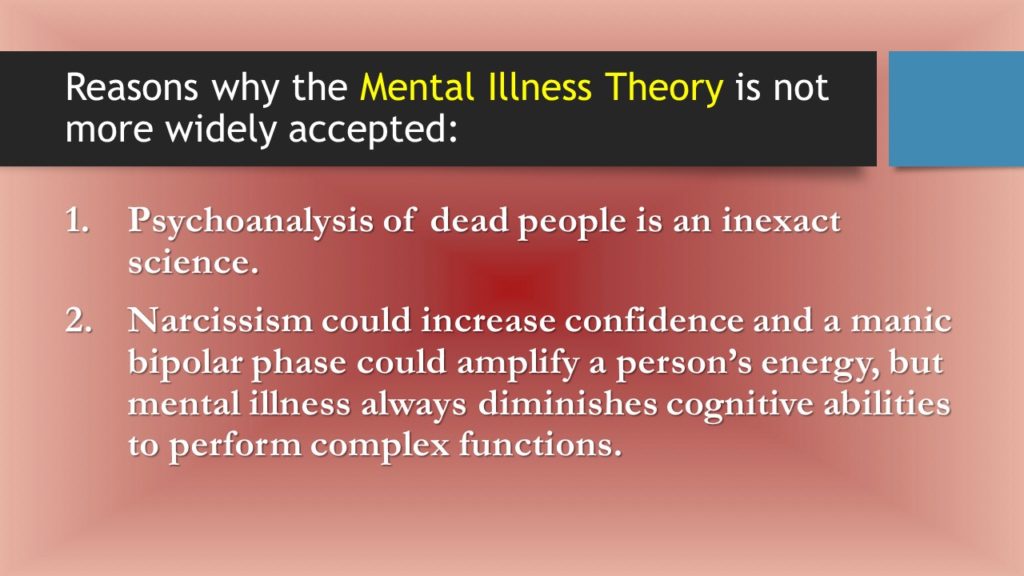
A second reason with respect to mental illness, narcissism could give someone more confidence in themselves, and [the] manic phase of bipolar disease could amplify a person’s energy. And if you’ve ever seen anybody in that, it’s remarkable their energy. But mental illness will always diminish a person’s cognitive abilities to perform complex functions. If this were not so, psychiatric hospitals would be teaming with all of these amazingly creative works of artists, and books, and things. And we just don’t see it. It’s just the opposite of that.

Automatic writing, this is a fun topic.
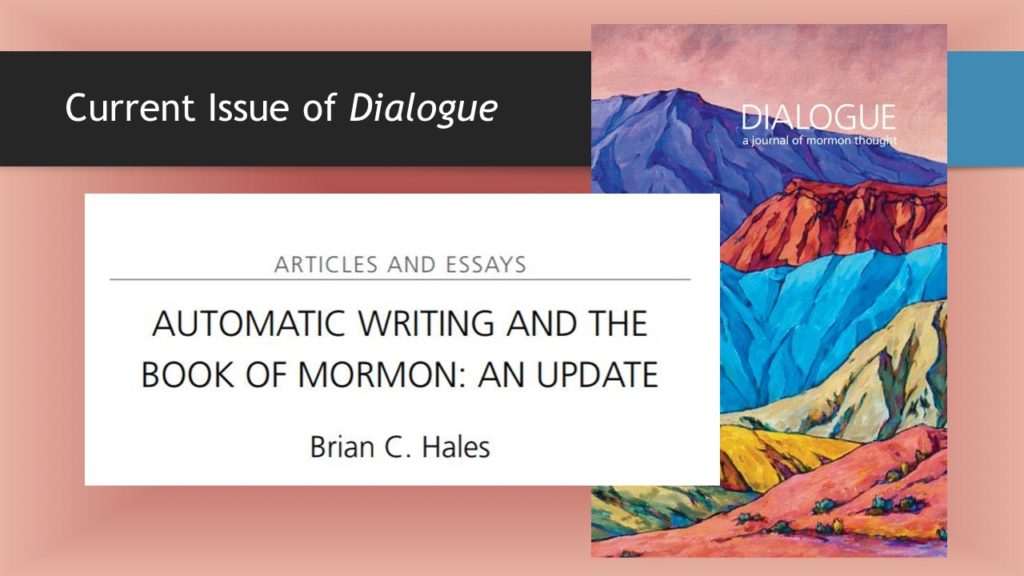
And I would refer you to the current of Dialogue. I have an article in there that has much more details than I’m able to present here today.

But “‘automatic writing’ is a term used to designate writing that is done without the writer being conscious of what he is writing… A person who writes automatically is usually in some altered state of consciousness.”

And before psychology got involved, there was spirit writing, trance writing, channeling. And these things had been known for hundreds of years. And these are words that could be spoken.

These are words that could be produced with a planchette that has a pencil or a pen on it, and you just move it around a paper.

There’s Ouija boards, which also could produce words fairly rapidly, as a matter of fact.

Now the characteristics of automatic writing is that there’s no prewriting, and there’s no rewriting.

In other words, if you go to a college campus and learn about creative writing, you’re going to learn there’s three basic stages. You prewrite; you get your notes, you get quotations, grab the books you’re going to us, and an outline, and then you write that first draft. And then you rewrite the draft. And you rewrite the draft. And you rewrite the draft. And you revise it. And you cut and paste, and you copy it, and you content edit, and all of these things.

But with automatic writing, you just write. The words are produced, and then they are usually published with very little change.

Sorry about this really busy slide. It’s reproduced in the article in Dialogue, which you can download for free as a pdf. But the first column—and what I’ve done here is tried to accumulate every automatic writer who has produced a long manuscript. And the first column is the name of the most popular of their manuscripts, the date it was published, the name of the author, the birthdate of the author, the education of the author, the number of words, and then the last column is where did all of the words come from according to that individual?

And one thing that we’ll notice is that there’s a breakdown in the education of the automatic writer versus the complexity of the book or essay that they’re writing. Very complex texts are being written by people with minimal education.

And if we go back to the chart, and I don’t know if you can see there, but I’ve highlighted that column. We can see that some of these people have PhDs, or they’re dentists or doctors, so they’re smart. That doesn’t necessarily mean they can write books, but they are educated. But several of the people really have minimal education, but they’re creating long complex texts.

A third characteristic is that all of these authors attribute the words to some force outside of themselves. If you ask them, where did the words come from? Did you make them up? None of them would say they came from me or I composed this text. They always attribute it to someone else.

And again, if you look at that last column, you can see that they’re in a trance state, or they’re talking to Jehovah, or they’re getting it from akashic records, or from someone named Seth, or a spirit guide, or something like this. But they aren’t claiming credit for these writings.

The most common, and I apologize Joseph and the Book of Mormon are at the bottom of that slide, and it’s cut off, but the most common automatic writing that’s compared to the Book of Mormon is called The Sorry Tale by Pearl Curran.

The Sorry Tale was published in 1917. It has 264,000 words. It was communicated through the spirit of a deceased woman named Patience Worth, who said she had lived in England in the 1600s. It came through a Ouija board, although Pearl Curran eventually got rid of the Ouija board; didn’t need it anymore. And before her death, Curran had communicated over 4 million words from this deceased person, Patience Worth. And the book The Sorry Tale is just one of several books that Pearl Curran composed.

If we compare the Book of Mormon and Joseph Smith to Pearl Curran and The Sorry Tale, there are a number of undeniable similarities. The authors had minimal education. There was no prewriting and no rewriting. There was just dictation. The word counts are similar. There is similar complexity, actually I think the Book of Mormon is more complex. The dictation sessions were of similar length. They would start where they’d previously ended the dictation. They didn’t go back and review or anything to start again. There was no editing. It went straight to the printer. And then both used an instrument, Joseph the seer stone and Pearl Curran used the Ouija board.

The naturalistic explanation for automatic writing is intriguing. It starts by talking about what we think with, and this is mostly stuff that was published by Freud. But he says our minds are made up of our conscious thoughts and then preconscious, preconscious being things we can immediately call up, as if I asked you, what was your first elementary school? You could probably remember that name, but it wasn’t on the stage of your mind before I asked it.

But then there’s an unconscious portion of our minds that’s made up of all kinds of feelings, and memories, and knowledge elements.

And through automatic writing, those unconscious elements are brought into consciousness.
Therapists will sometimes hypnotize their clients, their patients, and have them write in a trance. And sometimes they can use whatever is written to help them improve their mental health.

This has been reemphasized to us recently by Dr. Ann Taves in her book Revelatory Events.

And she theorizes in this book, and it was just published in 2016, that Joseph Smith would see the seer stone, and that would trigger a kind of a formal hypnotic induction. She called it an imaginative storytelling mode, a visual modality, or a highly focused awareness.

And once Joseph entered into this state, he was able to automate and effortlessly dictate the Book of Mormon. I talk a lot more about this in the article, if you look at it.

Now the reasons why automatic writing is not more popular among the secularists is that hypnosis does not transform a person into someone with greater creativity, memory, or cognitive function. That just doesn’t happen.

I’m going to give you just a few examples. Psychologist John F. Kihlstrom wrote, “Hypnosis appears to be incapable of enhancing memory [but] hypnotic procedures can impair memory.” And sometimes what will happen, and Dr. Taves and Scott Dunn have written on this, we’ll say that somebody under hypnosis remembered something that happened when they were five years old that they didn’t know that they could remember, and so therefore Joseph Smith could systematize all the memory needed to create the Book of Mormon. There’s kind of a leap there, but the memory doesn’t work that way in a trance state.

John A. Bargh and Ezequiel Morsella of Yale said, “Although concept activation and primitive associative learning could occur unconsciously, anything complex requiring flexible responding, integration of stimuli, or higher mental processes could not.”
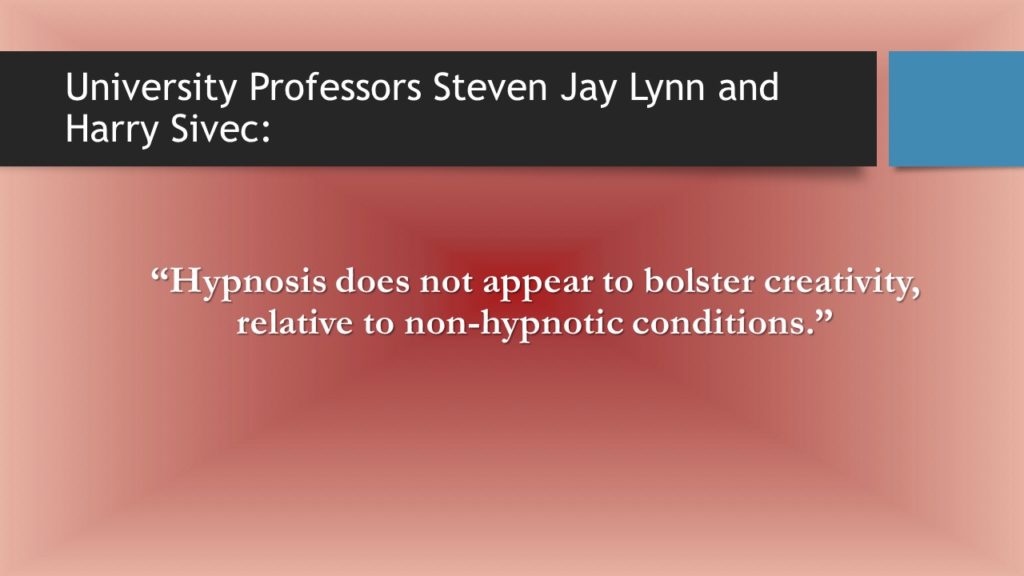
And then one other example, Hypnosis does not appear to bolster creativity, relative to non-hypnotic conditions.” And I’ve reviewed hundreds of articles and read dozens, you just can’t go into a trance state and suddenly become a super author or a super anything actually. It doesn’t increase your abilities.

A second problem with the automatic writing theory is that explaining an alleged supernatural activity with another alleged supernatural activity does not result in a naturalistic explanation. And we see critics will sometimes refer to The Sorry Tale and Pearl Curran and say, see, I’ve explained how Joseph did it. Well, not really. What they need is a naturalistic explanation for one of the processes and then maybe they could apply it to both.

Joseph Smith’s intellect theory. This is the funnest one of all.

We notice that it is the most popular today. There are very few people seriously promoting any other theory to explain how Joseph Smith generated all of those words.

The problem with all of these theorists, all of the advocates, is they treat Joseph like a black box.

What is a black box? Well a black box talks about inputs and outputs. It doesn’t talk about what’s going on inside of the box. And when we apply this to Joseph Smith, what we find among the critics is that they focus on the input.

They say he plagiarized the King James Bible. He borrowed from View of the Hebrews. He grabbed parallel phrases from a whole host of books. Or he grabbed things from his environment.

They will also attack the output of the book. Archaeology disproves the Book of Mormon. Indian DNA disproves the Book of Mormon. There are anachronisms and all kinds of changes, according to Jerald Tanner. And then linguistics disprove it.

And then what happens with most of the advocates of this theory is that they talk about these things in yellow as if they’re explaining how Joseph Smith generated all of the words. I’m not even sure that they really recognize the fact that talking about the input and the output doesn’t explain how Joseph was able to mentally create the Book of Mormon text. They ignore what’s going on inside.

So the question comes up, well, how would you open the box? I mean that’s a tall order.

How do you look inside somebody’s brain, especially when this happened in 1829?
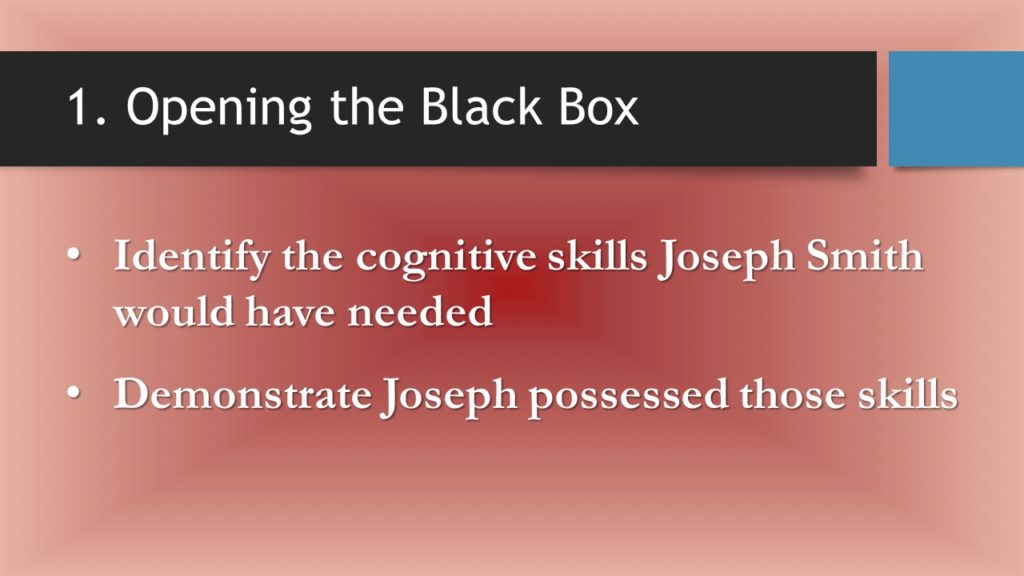
Well, I would offer two suggestions. One is that we identify the cognitive skill set that Joseph Smith would have needed to dictate the Book of Mormon, and then we simply demonstrate that he possessed most of those abilities.

You can ask, well, what does it take to create the Book of Mormon like Joseph did? Well, we don’t have studies on creative dictation, but we do have lots of studies on creative writing of long essays and long books. And there are people who have spent a great deal of time asking writers to think about what they’re thinking as they’re writing. And they’ve taken this research, and they’ve compiled different models.

This one by Linda Flower and John Hayes is the most popular. It was done in 1981. Again, it’s for creative writing. But what they came up with is this model here.

So what they’ve tried to do is figure out what’s going on in a writer’s mind as they’re writing all of the sentences that become a large book.

It starts with what they call the rhetorical problem, but this is really the motivation. What would motivate somebody to write a book? What is the issue that they’re trying to address?

In this model, the long-term memory actually included things outside of the brain of the writer. They were allowed to have books, and articles, and notes, and outlines, and things.

And then we have what’s going on inside the mind of the individual. And there’s different boxes there that you can see, and they define these. Just basically we’ve got the planning box, which is where there’s organization of the first attempts to create the words that eventually will go into the text.

There’s a section that is constantly reviewing what’s going on, and what they’re about to say, or write in the text.

And then it all comes together in what they call the translating stage.

And that becomes the words produced so far.

Now the question is—and I should point out, and this is important, that there is a feedback loop. In other words what they write is not the final draft. They can rewrite. So there’s a cycle there. They write, and then they revise, and then they write, and they revise, until they get to the final.
Now the question is, could we modify this creative writing model to apply to creative dictation, which is what the intellect theory says Joseph used to create all of the words? This is my version. And I welcome people to modify it or start from scratch. But I’ve had to make a few changes in the Flower-Hayes model in order to apply it to somebody who is dictating and not writing.

First, everything goes into the mind. And that’s a rhetorical problem, but it’s also everything from memory. Joseph used no manuscripts or books. So anything he was going to recall to be in the Book of Mormon, he had to preload into his brain.

And the intellect theory posits that Joseph had seven years of district schooling. He’d visited bookstores and libraries. He had been memorizing the Bible and scrutinizing View of the Hebrews, The Last War, and Napoleon’s First Book, and a whole bunch of other books. And that he’d been going to all kinds of camp meetings and religious revivals. And my friend Mike Quinn would say, he’d been reading lots of books on magic too. I mean he was a busy guy, according to this theory. The problem is there is just no credible evidence to support that Joseph was doing any of these things. He probably had a third-grade education, but these other things, there’s just no documentation for it. And there’s actually contradictory evidence in several cases.


We also find that the midterm and short-term memory, when you’re dictating a book, is highly taxed, highly burdened. Flower and Hayes said, “Each word in the growing text determines and limits the choices of what can come next.”

And it also taxes short-term memory. And so you’re wordsmithing a current sentence, lexical choices, syntactical choices. but you also have to remember the very last sentence so it will be coherent. So the memory is really burdened throughout this process.

And then notice this arrow. It goes one way. Once you dictate the sentence, you’re done. So that’s nice. But you’ve got to make sure it’s right the first time, or else you’re going to have a problem. There’s no reviewing allowed.

So this just demonstrates that draft 1 is the final draft. But with creative writing you can have multiple drafts and revisions.

What happens if we apply this model to Joseph Smith? Well, the motivation, what would motivate Joseph to fabricate the Book of Mormon is somewhat controversial. We have people saying, like Dan Vogel, that he was a kind deceiver, and he was sincere, and he wanted to do good, and he was willing to lie to do it.
But most, by far the vast majority of the secularists will refer to Joseph as simply wanting power, or money, and followers. And so there’s some controversy there. And you still have to ask, what would make somebody who wanted power or money choose to write a very long book, and carry on the ruse of looking in a hat at a stone for 57 days, or 84 days, or whatever the number is? It doesn’t naturally flow in my mind.
Now he probably had a third-grade education despite an article that says he may have had more. I won’t talk about that. But he probably was about our third-grade level.
His experiences were quite limited. A farmer, age 23, he did go to the coast after his operation on his knee. But we have Orsamus Turner who said that Joseph participated in a debate club occasionally, and that he was a passable Methodist Exhorter, but Turner also said he was below average intellect. So again, not finding a lot of extensive experiences.
We mentioned research wise there’s no one reporting that he was going to bookstores and libraries in the area to review things in anticipation of the book.
Creativity, we do have that one quote from Lucy Mack Smith that at times he would give recitals and talk about the early inhabitants of America, and the animals that they rode on, and things of this nature. So he definitely had some creativity looking at it from the intellect theory’s viewpoint.
The mid and the short-term memory, long-term memory of Joseph is difficult to assess. But we can look to 1835 when he was learning Hebrew from Joshua Seixas. He was not the star student. He didn’t manifest a photographic memory. In fact, Orson Pratt received a certificate saying you can teach Hebrew. Joseph’s certificate from Seixas said if you continue, you will become proficient. That’s not much of an endorsement really, but that’s all that Joseph got from Seixas. Joseph wasn’t dumb, and I’m not saying that at all, but we’re not finding super intelligent level of cognitive function in the historical record. And admittedly it’s not as complete as we would like.
Joseph had no reputation as a preacher prior to dictating the Book of Mormon, no reputation as a story-teller, improv.
So, as I apply the historical record to the model that I’ve created, I don’t find a real convincing set of evidence that Joseph would have been able to do this. Now I’m obviously biased. I’m here. I’m a believer. And the critics are more than welcome to modify this and to point out any weaknesses.

Now a second way to open this black box would be to design a study to duplicate what Joseph Smith did. Now it would be kind of a hassle. You’d have to tie up several people for two or three-month’s time. But guess what? We don’t have to do that. Almost anybody in this audience can replicate Joseph’s efforts, or at least attempt to, with this right here.

We don’t need Oliver Cowdery. We can use the voice-to-text app in our phones. And all you have to do is dictate a text message. Now it needs to be about 20 to 30 words at least. And before you dictate this text message, or before you hit the send button, correct the grammar, correct the spelling; Joseph went back and did this afterwards. And then you just have somebody receive the text message, and line them up one right after the other on the other end.


And then you just do this over and over, and over, and over, and over, and over, and over until you’ve done it about 10,000 times. Or until you have 269,320 words.



Now there are some restrictions if you want to emulate Joseph Smith’s efforts. First off you cannot rearrange a single sentence or text block after you hit send. And there’s a lot of remarkable characteristics about the initial stream of words that Joseph Smith spoke to his scribes. But to me this is one of the easiest to identify and talk about, because anybody who’s written a three-paragraph email knows that rearranging sentences is a real common phenomenon. And for Joseph Smith to have dictated nearly 7,000 sentences without rearranging a single one is a remarkable phenomenon. And these were long sentences.

If we compare the sentence length of the Book of Mormon to other fictional works, it’s two to three times the sentence length. And it also is interesting, if he’s dictating text blocks of 20 to 30 words, and the average sentence length is 40, he’s dictating partial sentences each time. And I don’t think that would have made it any easier.

You have to dictate without punctuation, and you might think that would make it easier. But BYU professor Roger Terry said, Joseph Smith’s “task stretches far beyond his ability to convert prelanguage concepts into the lengthy and layered sentence structure of the Book of Mormon. Without the guidance of punctuation to separate embedded clauses, this feat would have been mind-boggling.”

And the importance of commas cannot be understated. The Book of Mormon has almost 25,000 commas and almost 6,000 semicolons that were added by John H. Gilbert, who typeset the text. And my dear wife, my sweet companion who works as a professional editor said she’d be charging about $50 an hour to be putting all these commas in this text. It would be a challenge. But you have to dictate without any punctuation.

And of course, you have to use an alternate dialect or vernacular. And we’re all grateful to Royal Skousen and Stan Carmack who have looked at how Joseph dictated the Book of Mormon using a dialect that was not upstate New York. He’s not dictating in his everyday verbiage. He’s choosing to do it in something else. So, you can choose early English, you can choose jive, I don’t care what vernacular you want to choose, but if you wanted to replicate Joseph, choose something that is not your everyday speech.

You also need to not use words, specific words that you use in your everyday speech. There was a letter written by Joseph just weeks after the translation was finished. And in this letter he closes it by saying, “…now may God … receive us all to rest with him in eternal repose through the atonement of Christ our Lord.” The word repose does not appear in the Book of Mormon. The words peace or rest do, but this is the first word apparently, he chose for that application when he’s writing a letter just weeks after he’s finished the translation of the Book of Mormon, where he never used the word once.

Another example is a letter written a year after the Book of Mormon is published. It’s written from Kirtland by Joseph to his brother Hyrum. He says, I have been engaged in regulating the Churches here, as the disciples are numerous and the devil has made many attempts to overthrow them. It has been a serious job, but the Lord is with us, and we have overcome, and have all things regular. The word job does not appear in the Book of Mormon. The word labor in some form is there almost 100 times. Likewise, all things are mentioned many times in the Book of Mormon, but they are never listed as being regular. So, we see evidence that Joseph is doing this dictation, but he’s not using everyday speech.

I want to just suggest that for those that are advocates of the intellect theory, there’s an elephant in the room. And I don’t mean for this to be in any way disrespectful or snarky, but it’s like one will say, Joseph could do this naturally. And everybody seems to want to agree. But this elephant in the room that nobody to date has talked about is the difficulty of creative dictation, the ability that according to this theory Joseph did. He was able to dictate all of these sentences in all their complexity without having to go back and do any content editing of any kind.

To be honest with you, (this is a criticism of this theory) it seems the intellect theory is not really a theory at all, it’s just an assumption.

If Joseph Smith produced the Book of Mormon naturally, the process I think ought to be understandable and repeatable.
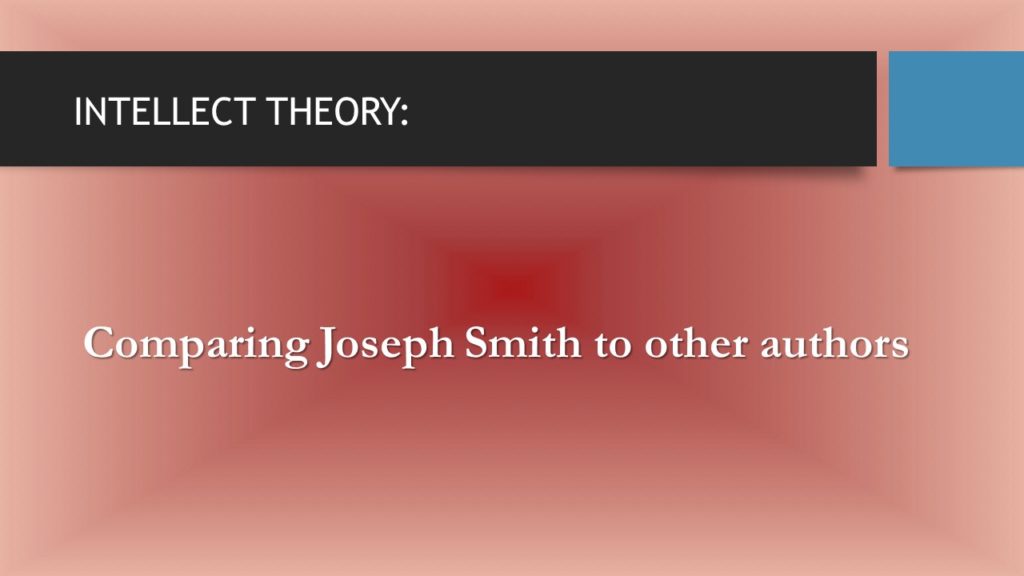
Now we’re going to shift gears just a little bit, because the intellect theory allows us to compare Joseph Smith and the Book of Mormon to other authors and their books.


Busy chart—I apologize, and I’m going over, so I’m going to go quickly. But what I’ve done here is accumulated every author under the age of 24 to publish a long book.

And if you re-stack the evidence, we discover the Book of Mormon is 50 percent longer than the next-longest book. If we look at the difficulty of the text, the Book of Mormon is at an eighth-grade level, all of these are simpler than that.

And then if we look at the education of the authors, they all have more education than Joseph except perhaps the one on the top, Mary Shelley.

And then it’s interesting that there were only three young authors before Joseph Smith, and they wrote books that were simpler and much shorter.

If we compare Joseph and his word count output, number of words he produced, we see the Book of Mormon at age 23. We see a little blip for the Joseph Smith translation, Book of Moses, Book of Abraham.

If we compare him to other authors, Tolkien is probably the most common. We find Tolkien wrote his book way late in life.
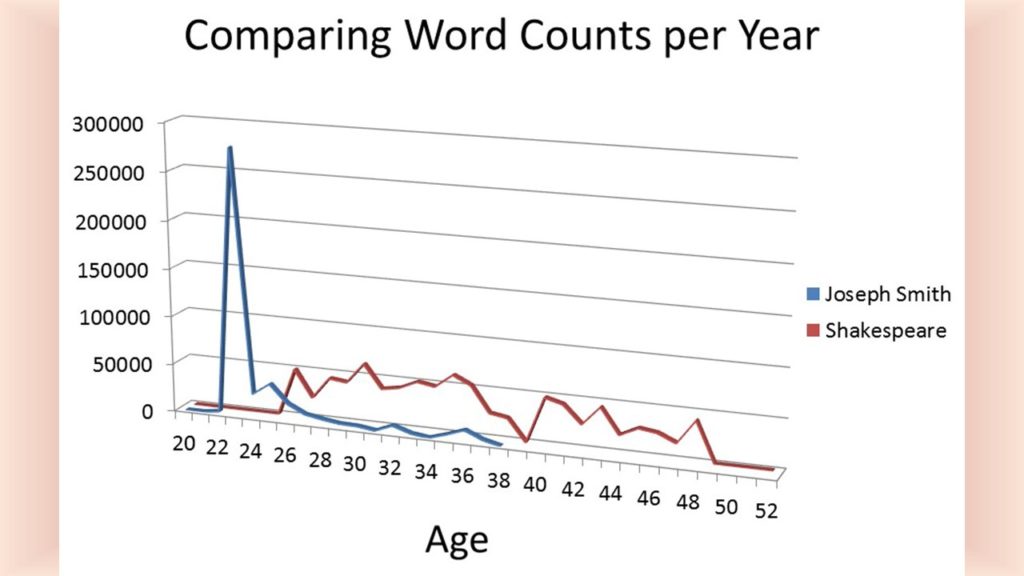
If we compare Joseph to Shakespeare, which they do on MormonThink, we find that Shakespeare was very constant. He wrote a play every year, sometimes two except for one year. But by the age that Shakespeare completed his first play, Joseph had completed 85 percent of everything he was going to produce.

I had to include J. K. Rowling, because I just love those movies. Again, we see a difference. It’s later, there’s some crescendo there in the publication.

Joseph just pops out as being somewhat unique.

Now I will be honest with you, I’ve studied these for four years, these theories. I don’t think any of them are plausible. But again, I admit my biases right up front.


I’ve been accused of trying to prove the Book of Mormon is true. I’m not doing that either. We don’t prove supernatural phenomena through natural evidences. But God observed that the coming forth of the Book of Mormon, and He describes that in D&C 20:7-10, is “Proving to the world that the holy scriptures are true, and that God does inspire men.” The word proving here is not mine.

Of course, the world will not accept the proof. All naturalistic theories portray Joseph as a deceiver. This is one of the problems with the naturalistic theories, is that in every one Joseph is a deceiver. He’s doing the head in the hat as a ruse. Deceivers are all actors. And the Book of Mormon, however, is much more than a stage prop. In other words, actors don’t write books. Authors write books. So, the “Joseph the deceiver” theory kind of breaks down in the Book of Mormon, because an actor wouldn’t be expected to do that. It would take a real author, which is what Joseph has apparently done in authoring the Book of Mormon. The Book of Mormon is the real thing.

I would just close by saying that it seems that the heaven touched the earth in the creation of the Book of Mormon, at least that’s my theory. Thanks.
Q&A
We have about five minutes, and there’s lots of long questions here. Let me see if I can find a short one.
Q: Why does the Book of Mormon seem so post-Christian in orientation? Why the King James language, different translation, different orientation?
A: It’s an excellent question. And it’s interesting, for decades critics have used what we call intertextuality with the King James Bible and the 19th century elements that are in the Book of Mormon as evidence that the book must have come from Joseph Smith. And what we’re learning now is that the Book of Mormon is so complex, and with the use of computers and works of Neil Frederick and others [like] Joe Spencer, this intertextuality is so subtle that what they’re doing by observing these things in this Book of Mormon that is this complicated, and then we see how in the 19th century elements and the intertextuality with the Bible is inter-grained, it’s actually much more complex.
How could Joseph had done that just spewing forth words as a stream to Oliver Cowdery? In other words, the level of complexity we’re discovering in the text is actually in my view demonstrating there’s no way Joseph could have done this. This makes it harder for him to do it.
Now where did this stuff come from? I share the same opinion with Royal Skousen, with Grant Hardy, who’s a Book of Mormon scholar, with Richard Bushman, who all believe that whatever was written on the plates is not the revelation Joseph Smith was dictating; that there was some modification that makes the Book of Mormon more specially designated for our time and for our people. And so, they’re saying what Joseph is getting is not strictly what was on the plates. It included what was there, but these things were added by some interim translator or something. That’s their theory. And frankly, I think that’s a good way to explain it.
So, the intertextuality 19th century elements in my mind are evidence that Joseph could not have done it, even though they have been a very strong evidence for the critics that he could have.
Q: What about direct quotes from the King James Bible? What about French in the Book of Mormon?
A: When you translate, you’re going to use words from your language. I mean the French word adieu, people get worried about that. But it’s in the English dictionary of 1828. I mean it had been part of the English language. English speakers were using words like this. I talked about the King James.
Q: What about a combination—how does modern tech change our assumptions about creative writing? Prior to word processors, or even typewriters, would rearranging sentences really be a common or central part of the process?
A: I think early writers would rearrange sentences. I don’t think Great Expectations was written one sentence after another without any subsequent modification. Yeah. There were editors back then, but Joseph didn’t have one. So…
Q: What about the theory that Spalding had a different book than the one that was found?
A: And I actually pulled the slide last night, because I knew I was too long. There is an alternate theory that Spalding wrote two manuscripts, the second one was actually the one that had the same names as the Book of Mormon, and that’s the one that came through Rigdon and all. There’s just no support of the evidence for Ridgon being involved, and there’s problems at every turn with this theory. It’s fun if you want to read about it, but the historical record is not kind to any theory that wants to put Spalding involved with the Book of Mormon.
Q: How good was the literature that Pearl Curran dictated via automatic writing? Was it substantive, complex, and coherent?
A: Yes, and yes. But she used a really weird dialect. I haven’t read the entire Sorry Tale, because it is so difficult to figure out in English what she means, because she’s using—it’s not early English, it’s just a variant that she made up. And it became better over time. Her later books were easier to understand, but they were complex. They weren’t simple tales. I don’t think The Sorry Tales is as complex as the Book of Mormon.
Q: On psychologists, don’t forget William James early psychologist, Joseph Smith was judged to have been [had?] genuine religious experiences.
A. Okay, I’m not understanding. Sorry.
Q: Shouldn’t Joseph be compared to other oral storytellers rather than authors?
A: I love this question. There’s a book out about Bosnian storytellers. And these guys could go on for days. And William Davis talks about it in a PhD dissertation. It’s fascinating, but even he admits there’s not a real parallel, because these storytellers are going on for hours by taking the king that they’re talking about and telling us about his earrings, and about his robe, and about the sash on the robe. I mean there’s not the complexities that we see in the Book of Mormon. That’s not how they’re getting their long narratives. And like I say, even Bill Davis acknowledges that it’s not a real good parallel.
Q: What about the fallen prophet theory?
A: That’s kind of a personal thing. I believed in 1829 he was a prophet, and I’ve studied all of Nauvoo. I don’t like polygamy; I never want to practice it, but I do defend Joseph as a worthy prophet. I don’t think there was anything there that he did that would have caused him to lose the spiritual gifts that he’d been given. Thank you.
[Note: transcript lightly edited for clarity and readability]
